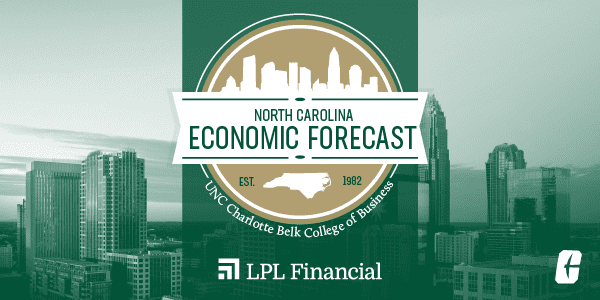Forecast: Conflicting forces create opportunity for recession or return of inflation

A mild recession or a return of inflation are both possibilities in the coming months, depending on how conflicting federal monetary and fiscal policies and other economic factors play out.
“While the Federal Reserve is putting the brakes on inflation by raising interest rates, Congress and the president are continuing to stimulate the economy with fiscal policy deficit spending,” said John Connaughton, professor of financial economics for UNC Charlotte’s Belk College of Business. “After 16 months of increasing interest rates, the conventional wisdom would suggest that the economy should be slowing, or we should be seeing signs of recession. But so far this has not occurred.”
Connaughton, who released the North Carolina Economic Forecast Third Quarter Report during a virtual presentation on Thursday, Sept. 7, put the chance of a recession in 2024 at 50-50, but said that a resurgence of inflation cannot be ruled out.
“It is quite possible we will see a mild slowdown during the fourth quarter of 2023 or the first quarter of 2024, but if federal fiscal spending continues unabated, the economy may continue to grow, with inflation coming back in 2024,” he said. The potential return of inflation would be led by government spending rather than by consumers and business, he said.
Recent data suggest the U.S. economy is stronger than most economists believed just three months ago, according to the report.
“As recently as Sept. 1, 2023, the Atlanta Fed GDPNow tracker indicated that third quarter U.S. GDP is likely to increase by 5.9%,” Connaughton said. “That is hardly indicative of a recession.”
Gross Domestic Product Analysis
For 2023, North Carolina’s real (inflation-adjusted) GDP is forecast to increase by 2.4% over the 2022 level, the report indicated.
Connaughton expects an output increase for 13 of the state’s 15 economic sectors during 2023. The sectors with the strongest expected growth rates include:
- Information: 11.2%
- Retail Trade: 5.6%
- Educational and Health Services: 4.9%
- Hospitality and Leisure Services: 4.6%
- Business and Professional Services: 4.4%
Expectations are that two sectors will experience declines during 2023:
- Construction: -3.7%
- Nondurable Goods Manufacturing: -2.0%
Employment
Of the state’s 14 nonagricultural sectors, 12 are forecast to see employment increases during 2023. The sectors with the strongest expected employment gains are:
- Mining: 5.6%
- Educational and Health Services: 3.6%
North Carolina employment is projected to reach 4,950,400 persons by December 2023, a 2.0% increase over the December 2022 employment level. The state is expected to add 96,900 net jobs in 2023. The state unemployment rate declined during the first half of 2023 to 3.3% in July and is expected to increase slightly to 4.0% by December 2024, according to the report.
2024 Preview
Looking ahead to 2024, the report forecasts modest growth. North Carolina employment is expected to add 53,400 net jobs, reaching 5,003,800 persons by December 2024, a 1.1% increase over the anticipated December 2023 employment level.
Considering North Carolina’s Gross Domestic Product, the real (inflation-adjusted) growth rate for 2024 is projected to increase by 2.4%. All 15 of the state’s economic sectors are expected to experience output increases during 2024.
The North Carolina Economic Forecast, which debuted in 1982, is released quarterly. The full report and a recording of the presentation will be available at belkcollege.charlotte.edu/forecast.
The North Carolina Economic Forecast is supported by LPL Financial. The fourth quarter report will be released in December.